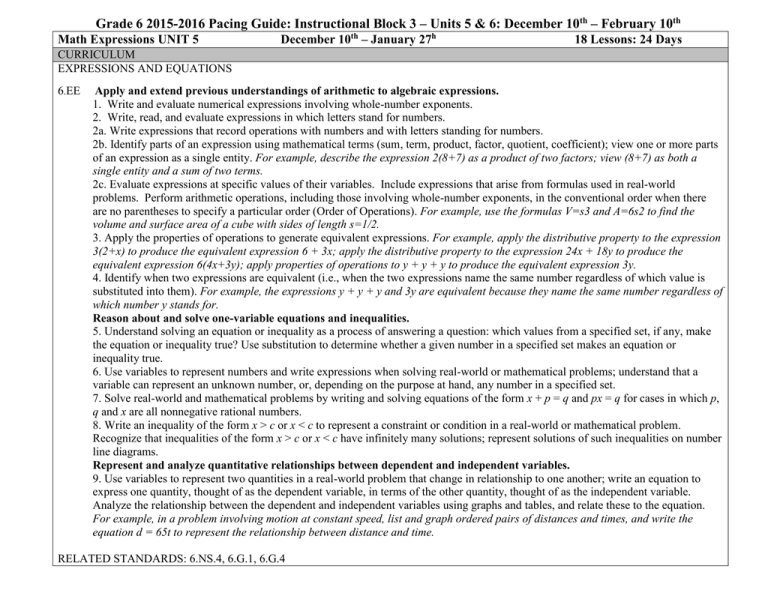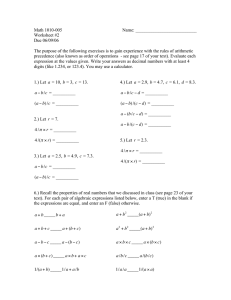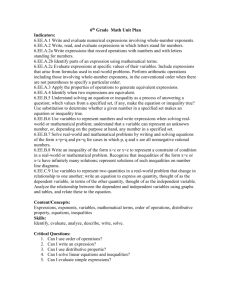Grade 6 Pacing Guide Block 3 Unit 5
advertisement

Grade 6 2015-2016 Pacing Guide: Instructional Block 3 – Units 5 & 6: December 10th – February 10th Math Expressions UNIT 5 December 10th – January 27h 18 Lessons: 24 Days CURRICULUM EXPRESSIONS AND EQUATIONS 6.EE Apply and extend previous understandings of arithmetic to algebraic expressions. 1. Write and evaluate numerical expressions involving whole-number exponents. 2. Write, read, and evaluate expressions in which letters stand for numbers. 2a. Write expressions that record operations with numbers and with letters standing for numbers. 2b. Identify parts of an expression using mathematical terms (sum, term, product, factor, quotient, coefficient); view one or more parts of an expression as a single entity. For example, describe the expression 2(8+7) as a product of two factors; view (8+7) as both a single entity and a sum of two terms. 2c. Evaluate expressions at specific values of their variables. Include expressions that arise from formulas used in real-world problems. Perform arithmetic operations, including those involving whole-number exponents, in the conventional order when there are no parentheses to specify a particular order (Order of Operations). For example, use the formulas V=s3 and A=6s2 to find the volume and surface area of a cube with sides of length s=1/2. 3. Apply the properties of operations to generate equivalent expressions. For example, apply the distributive property to the expression 3(2+x) to produce the equivalent expression 6 + 3x; apply the distributive property to the expression 24x + 18y to produce the equivalent expression 6(4x+3y); apply properties of operations to y + y + y to produce the equivalent expression 3y. 4. Identify when two expressions are equivalent (i.e., when the two expressions name the same number regardless of which value is substituted into them). For example, the expressions y + y + y and 3y are equivalent because they name the same number regardless of which number y stands for. Reason about and solve one-variable equations and inequalities. 5. Understand solving an equation or inequality as a process of answering a question: which values from a specified set, if any, make the equation or inequality true? Use substitution to determine whether a given number in a specified set makes an equation or inequality true. 6. Use variables to represent numbers and write expressions when solving real-world or mathematical problems; understand that a variable can represent an unknown number, or, depending on the purpose at hand, any number in a specified set. 7. Solve real-world and mathematical problems by writing and solving equations of the form x + p = q and px = q for cases in which p, q and x are all nonnegative rational numbers. 8. Write an inequality of the form x > c or x < c to represent a constraint or condition in a real-world or mathematical problem. Recognize that inequalities of the form x > c or x < c have infinitely many solutions; represent solutions of such inequalities on number line diagrams. Represent and analyze quantitative relationships between dependent and independent variables. 9. Use variables to represent two quantities in a real-world problem that change in relationship to one another; write an equation to express one quantity, thought of as the dependent variable, in terms of the other quantity, thought of as the independent variable. Analyze the relationship between the dependent and independent variables using graphs and tables, and relate these to the equation. For example, in a problem involving motion at constant speed, list and graph ordered pairs of distances and times, and write the equation d = 65t to represent the relationship between distance and time. RELATED STANDARDS: 6.NS.4, 6.G.1, 6.G.4 Grade 6 2015-2016 Pacing Guide: Instructional Block 3 – Units 5 & 6: December 10th – February 10th Math Expressions UNIT 5 December 10th – January 27h 18 Lessons: 24 Days Vocabulary Models Strategies INSTRUCTION: Math Expressions Unit 3/engageny Math Module 2, Topic B Lessons 1 – 5: Writing, Interpreting, and Analyzing Expressions Lessons 6 – 9: Equivalent Expressions Lessons 10 – 13: Representing and Describing Quantitative Relationships Lessons 14 – 18: Solving Equations and Inequalities ASSESSMENT Quick Quiz 1 Quick Quiz 2 Quick Quiz 3 Quick Quiz 4 Unit Test Lessons 5, 6, 7, and 14 may take 2 days ST Math Properties of Operations/ Using Parentheses/ Solving One-Step Equations/Linear Relationships/Exponents



